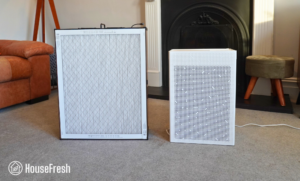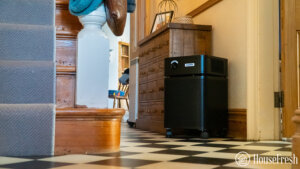COVID-19 and wildfire smoke covering the NYC skyline showed the importance of keeping the air in our homes clean of pollutants.
Sadly, the air purifier industry is full of many bad actors, with manufacturers claiming lab reports that don’t exist and exaggerating room size recommendations — and even big media publications recommending sub-par devices just to earn a higher affiliate commission off your purchase.
But improving the air quality inside your home doesn’t need to burn a hole in your pocket.
Since 2020, we have bought and thoroughly tested 110 air purifiers (and counting!) with the goal of separating the good from the absolute scams.
HouseFresh picks: The best air purifiers we tested
These are our recommendations for the best air purifiers you can buy today.
Our shortlist includes nine air purifiers in total, including both recently released models and reliable classic units that are still worthy of recommendations. Read till the end to find out about the solid air purifiers that didn’t make the cut — and the ones that we tested that are not a good investment.
1. Best for most people: Levoit Vital 200S
A high-performing air purifier with cleaning power that matches units sold for double its price.
The Vital 200S is our top choice because it offers good air cleaning performance without ionization, is relatively quiet, has a removable pre-filter, doesn’t take up lots of space, has smart functions, connects to your phone AND costs less than $200. This device will tick off most boxes for most people.
CONS
PROS



With the Vital 200S you will get excellent performance at top speed and quiet speeds, smart functions and app connectivity for an affordable price. It completed our particle removal test in just 23 minutes — which is nearly as fast as devices costing upwards of $500.
Check out the Winix 5510 as it offers similar air cleaning performance as the Vital 200S but it comes with a True HEPA filter.
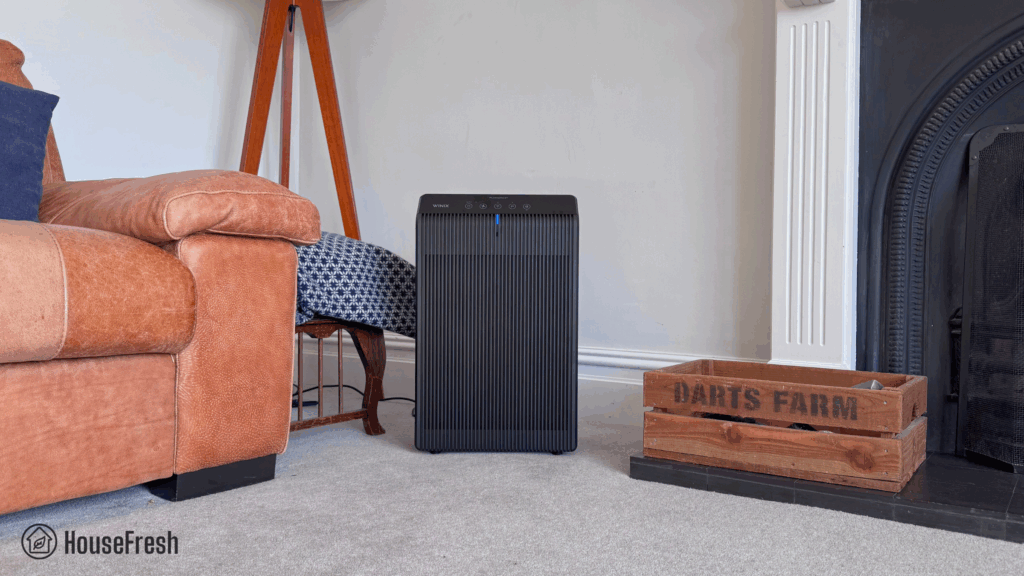
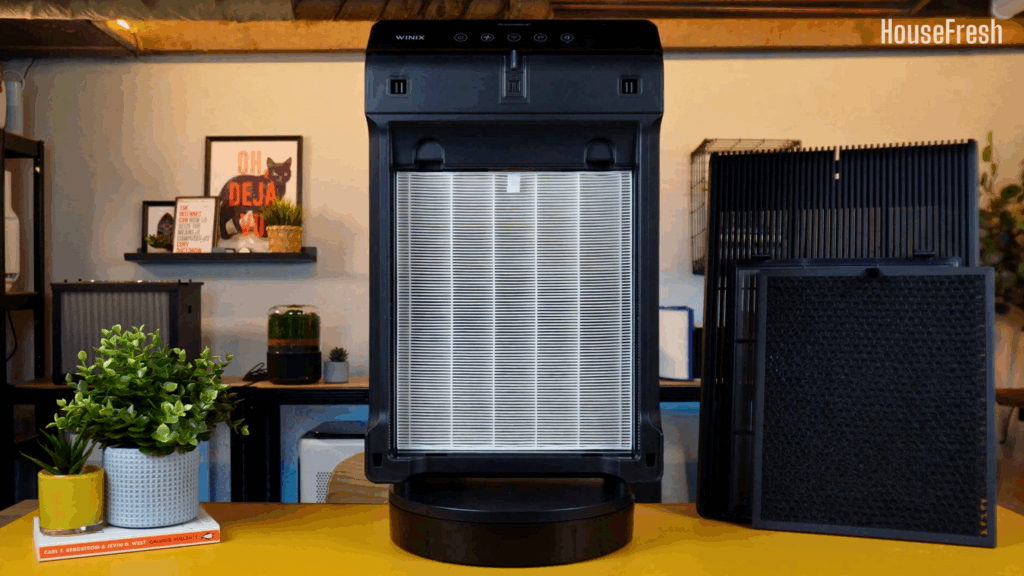
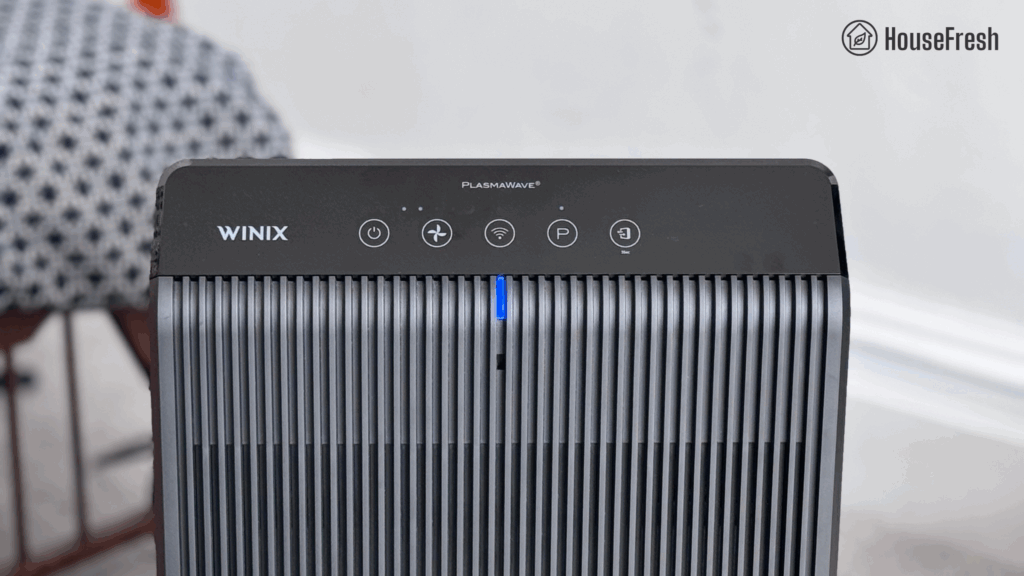
CONS
PROS
2. Best value for money: AirFanta 3Pro
The PC fan-powered 3Pro is one of the best-performing air purifiers to date with a super budget-friendly initial price.

Use the discount code HOUSEFRESH for 5% off when buying directly from AirFanta.
With a design inspired by the Corsi-Rosenthal Box, the 3Pro is a box with a plastic base, four H11 HEPA filters (with optional pelleted carbon) at each side and four PC fans on top. You can disassemble and reassemble the 3Pro to bring it with you inside a carry-on suitcase or large backpack wherever you go.
CONS
PROS



In our particle removal test, the AirFanta 3Pro removed all the PM1 pollutants from our incense smoke test in 17 minutes. The 3Pro ranks #5 as one of the fastest air purifiers we tested, and you can buy it for less than $160.
3. Best for small spaces: Winix A231 (a.k.a. Zero Compact)
Affordable, energy-efficient and compact, the Winix A231 (or A230 in black) is a great choice for rooms smaller than 200 sq. ft.

I recommend people buy air purifiers with a minimum CADR of 200 cfm because small tabletop devices are usually underpowered, run loud, and need filters changed more regularly than larger units. That said, if you need a small device, look no further than the Winix A231 (or A230 in black). It offers better air cleaning performance than all other small air purifiers we’ve tested, and you can buy it for less than $80.
CONS
PROS



This is a small air purifier, so you shouldn’t use it in rooms larger than 200 sq. ft. However, if you have limited space and need to find a small device you can place on top of a side table, then the Winix A231 is the best option on the market.
| HouseFresh rating: | ★★★★★ |
| Time to clean our 728 cubic feet test room (with the device running at top speed): | 40 minutes (with PlasmaWave) |
| Air purifier technology: | Fine mesh pre-filter, True HEPA filter, activated carbon filter, PlasmaWave technology |
| Recommended room size (4.8 air changes per hour): | 231 sq. ft. |
| Clean air delivery rate (CADR): | Dust: 154 CFM Smoke: 149 CFM Pollen: 147 CFM |
| Dimensions (in inches / in cm): | 9.5D x 9.5W x 14.6H inches (24.13D x 24.13W x 37H cm) |
| Weight (in pounds / in kg): | 7.1 lbs (3.2 kg) |
| Filter life: | 12 months |
| Noise level in decibels (measured from 3 ft. away with a sound level meter): | Speed 1: 35.2 dB Speed 2: 48.3 dB Speed 3: 57.9 dB |
| Electricity consumption in watts (recorded with an electricity usage monitor): | Standby mode: 0.06 watts Speed 1: 35.4 watts Speed 2: 37.7 watts Speed 3: 45.6 watts |
| Estimated running cost (electricity consumption + official filter replacement): | $119.54 per year |
| Cost per CADR cfm (based on dust CFM as reported by AHAM): | $0.51 |
| Manufacturer’s warranty: | 2 years |
| Country of manufacture: | South Korea |
4. Best for large spaces: Levoit Core 600S
The 600S offers an impressive CADR of 373 cfm (dust), smart functions and app connectivity for less than $300.
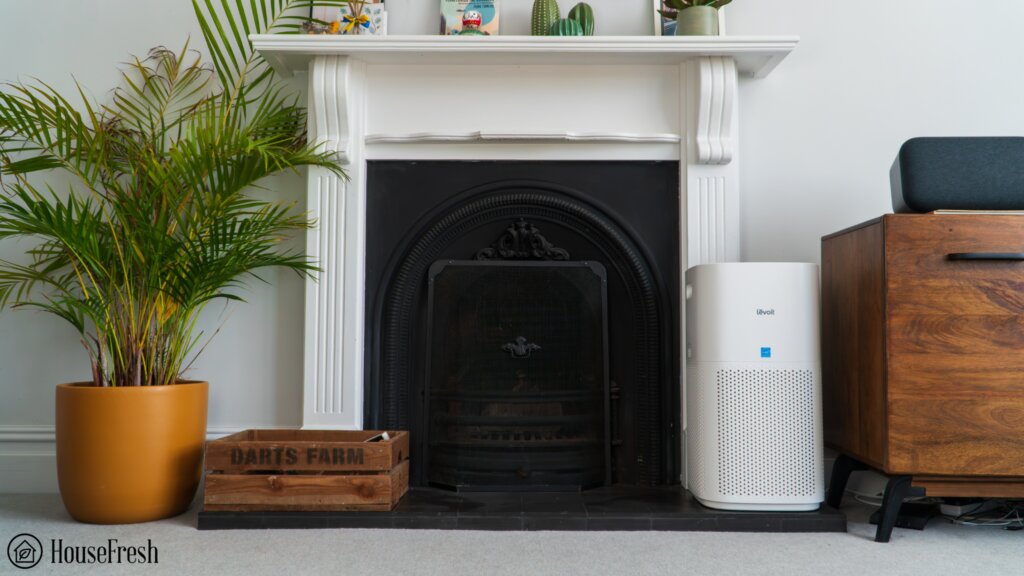
In the past, if you needed to clean the air in an area larger than 500 sq. ft., you would need to pay upwards of $500. But in 2025, you can get up to five (5!) air changes per hour in spaces up to 559 sq. ft. for just $299.99 if you get yourself a Levoit Core 600S.
CONS
PROS
For less than $300, the Levoit Core 600S includes an auto-mode, an onboard screen showing current air quality levels and even app support. For raw cleaning power for larger spaces, the Core 600S offers the most bang for your buck in rooms of up to 559 sq. ft. Be aware, though, that this is a big air purifier that will require floor space.

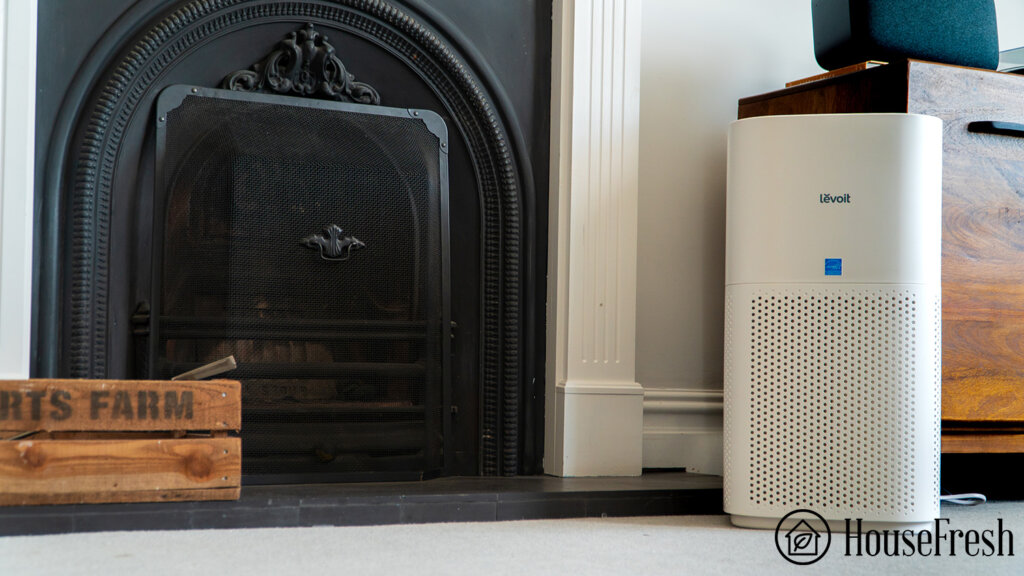

| HouseFresh rating: | ★★★★★ |
| Time to clean our 728 cubic feet test room (with the device running at top speed): | – 16 minutes (top speed) – 32 minutes (sub-45 dBA speed) |
| Air purifier technology: | Pre-filter, particle filter for airborne particles and activated carbon filter. |
| Recommended room size (5 air changes per hour): | 559.5 sq. ft. |
| Clean air delivery rate (CADR): | Dust: 373 CFM Smoke: 377 CFM Pollen: 437 CFM |
| Dimensions (in inches / in cm): | 12.3 x 12.3 x 23.6 inches (31.3 x 31.3 x 60 cm) |
| Weight (in pounds / in kg): | 13.7 lbs (6.2 kg) |
| Filter life: | 6 months |
| Noise level in decibels (measured from 3 ft. away with a sound level meter): | Speed 1: 40.9 dB Speed 2: 45.9 dB Speed 3: 61.4 dB |
| Electricity consumption in watts (recorded with an electricity usage monitor): | Standby mode: 1.53 watts Speed 1: 7.92 watts Speed 2: 11.35 watts Speed 3: 21.15 watts Speed 4: 49.27 watts |
| Estimated running cost (electricity consumption + official filter replacement): | $174.71 per year |
| Manufacturer’s warranty: | 2 years |
| Country of manufacture: | China |
5. Best for smoke and odors: IQAir HealthPro Plus
A Swiss-quality air purifier released in 1998 that is packed with 5 lbs of activated carbon and cleans the air as effectively as new devices.
While many air purifiers come with activated carbon filters, these are often far too small to deal with severe odor issues like cigarette smoke or chemical gases. But this is where the IQAir HealthPro Plus shines, thanks to a gas filter with over 5 lbs of activated carbon and zeolite.
CONS
PROS
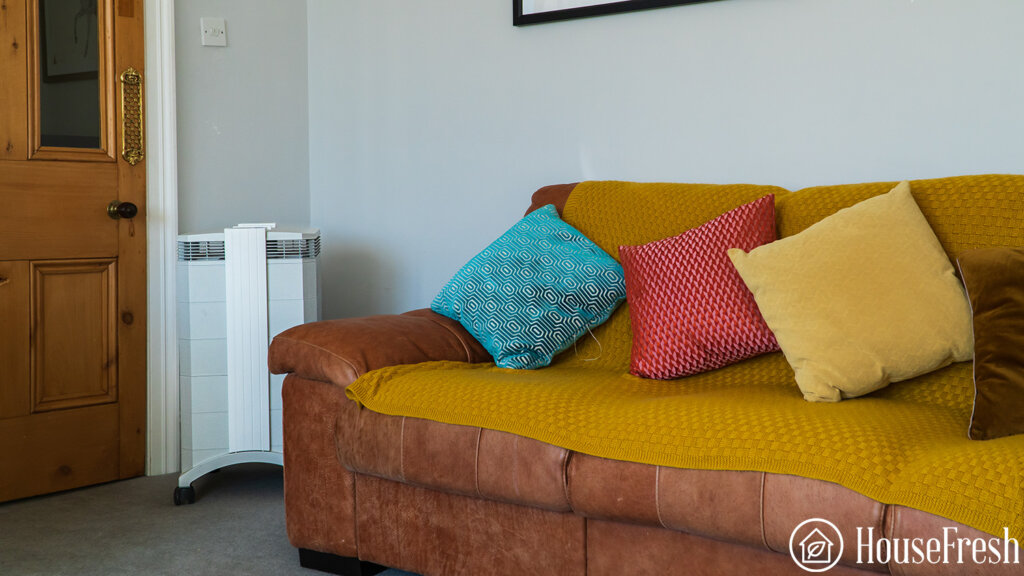

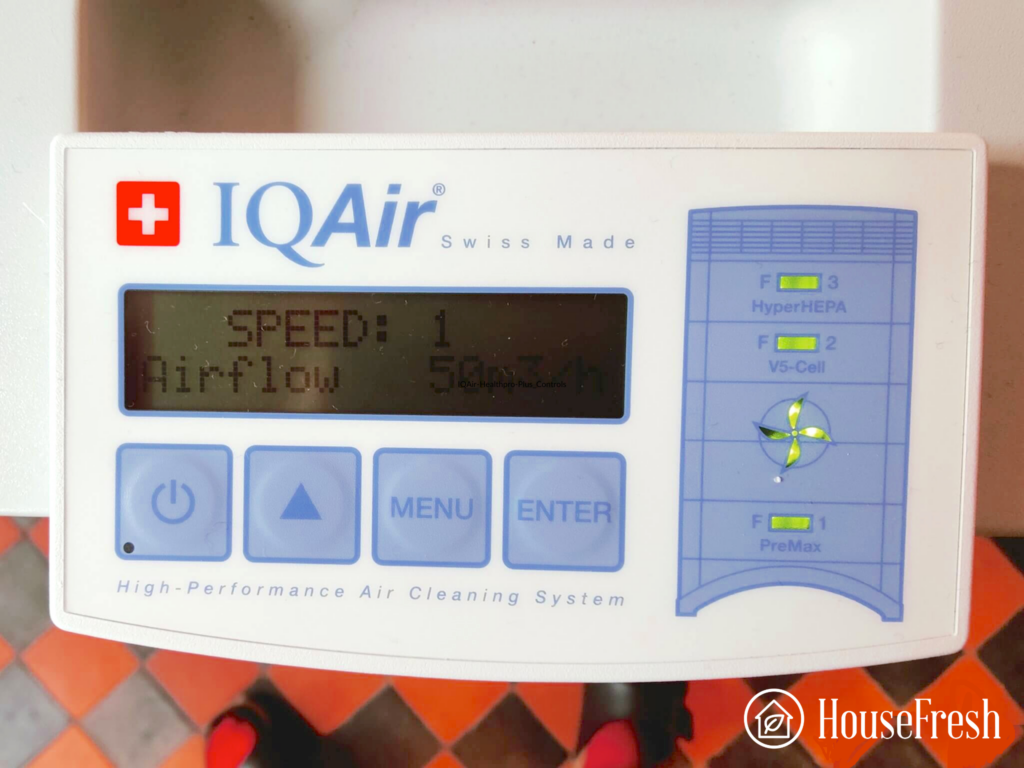
Paired with a powerful fan, it provides effective gas and odor removal — it cleaned our test room of all PM1 particulate matter in 28 minutes. The Austin Air Healthmate is another device that comes packed with A LOT of carbon, but it failed to make this list as it’s too underpowered in terms of particulate removal for such a hefty price ($700). The IQAir HealthPro Plus provides much better value.
| HouseFresh rating: | ★★★★★ |
| Time to clean our 728 cubic feet test room (with the device running at top speed): | 28 minutes |
| Air purifier technology: | HyperHEPA and V50-CELL gas and odor filter |
| Recommended room size (5 air changes per hour): | 375 sq. ft. |
| Clean air delivery rate (CADR): | Estimated: 250 CFM |
| Dimensions (in inches / in cm): | 28H x 18W x 16D inches (71H x 38W x 41D cm) |
| Weight (in pounds / in kg): | 35 lbs (15.88 kg) |
| Filter life: | 4 years |
| Noise level (measured from 3 ft. away): | Speed 1: 36.9 dB Speed 2: 37.2 dB Speed 3: 40.9 dB Speed 4: 47.2 dB Speed 5: 53.9 dB Speed 6: 61.2 dB |
| Electricity consumption in watts (recorded with an electricity usage monitor): | Standby mode: 1 watts Speed 1: 16.5 watts Speed 2: 32.7 watts Speed 3: 47.3 watts Speed 4: 69 watts Speed 5: 94.3 watts Speed 6: 145.2 watts |
| Estimated running costs (electricity consumption + filter replacements): | $421.47 per year |
| Cost per CADR cfm (based on dust CFM as reported by AHAM): | $3.60 |
| Manufacturer’s warranty: | 10 years |
| Country of manufacture: | Switzerland / Germany |
6. Best quiet option: CleanAirKits Luggable XL-7
This PC fan-powered air purifier generates 38.8 dB of noise and still managed to clear our test room faster than most popular traditional HEPA devices.

The Luggable XL-7 is the quietest air purifier I have ever tested. It combines a lightweight wooden case, seven Cooler Master SickleFlow 120 PC fans and two 20x25x1 MERV 13 filters (you can use any brand but I recommend the 3M Filtrete MPR1900).
CONS
PROS



If you want to build your own Luggable, CleanAirKits will send you a box with five or seven Cooler Master SickleFlow 120 PC fans (depending on which option you choose), four hardboard panels (one with an integrated handle), a power supply, internal pre-tensioner cords, foam tape strips and fan guard grills. You can also go for the pre-built Luggable XL, which costs $299 (versus the $227 of the DIY kit).
| Clean air delivery rate (CADR): | – Top speed PM1 CADR: 260 cfm – Sub-45 dBA PM1 CADR: 260 cfm – Intertek PM2.5: 323 cfm (dust) |
| Filter technology: | MERV 13 (20×25) |
| Recommended room size: | 390 sq. ft. (5 air changes per hour) |
| Dimensions: | 7D x 25W x 20H in (18D x 64W x 51 cm) |
| Weight: | 8 lbs (3.63 kg) |
| Noise level in decibels from 3 ft. away: | Only speed: 38.8 dBA |
| Electricity consumption in watts: | Only speed: 10.5 watts |
| Filter lifespan: | 6-12 months |
| Manufacturer’s warranty: | 1 year |
| Country of origin: | United States |
| Country of manufacture: | United States |
For those of you living in Canada, check out the 6XL from NorthBox Systems as it is just as good as the Luggable XL-7 but it is made in Canada by a local father and son business:
7. Best stylish option: Winix T810
A mid-sized cylindrical air purifier that won’t look out of place in the trendiest of spaces.
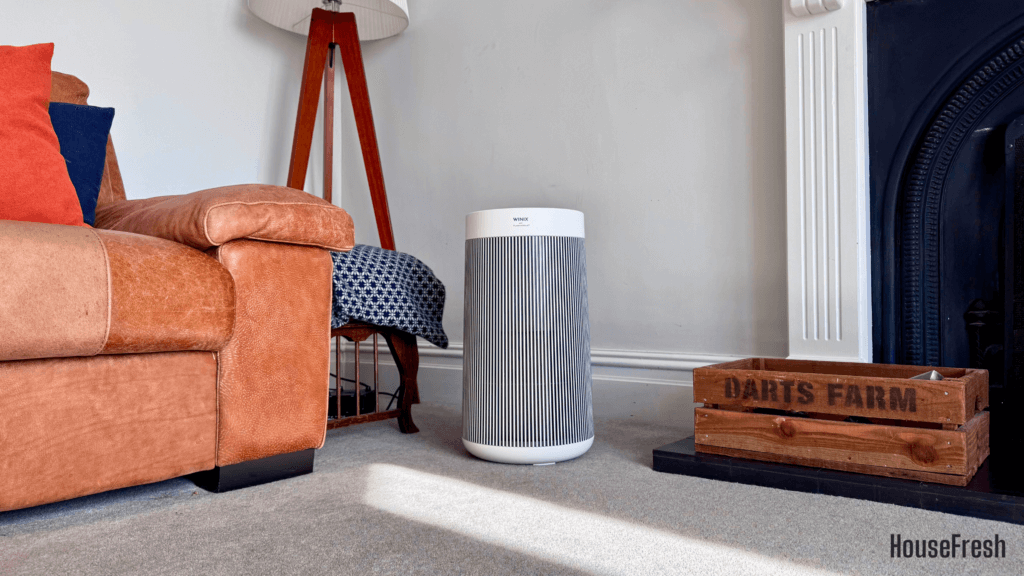
The Winix T810 is the perfect choice for those looking for a good-looking air purifier with smart functions and app support for less than $250. its cylindrical design allows the T810 to pull air in from all sides, which translates into a high CADR (229 cfm PM1) in a relatively small package that won’t take up too much floor space.
CONS
PROS
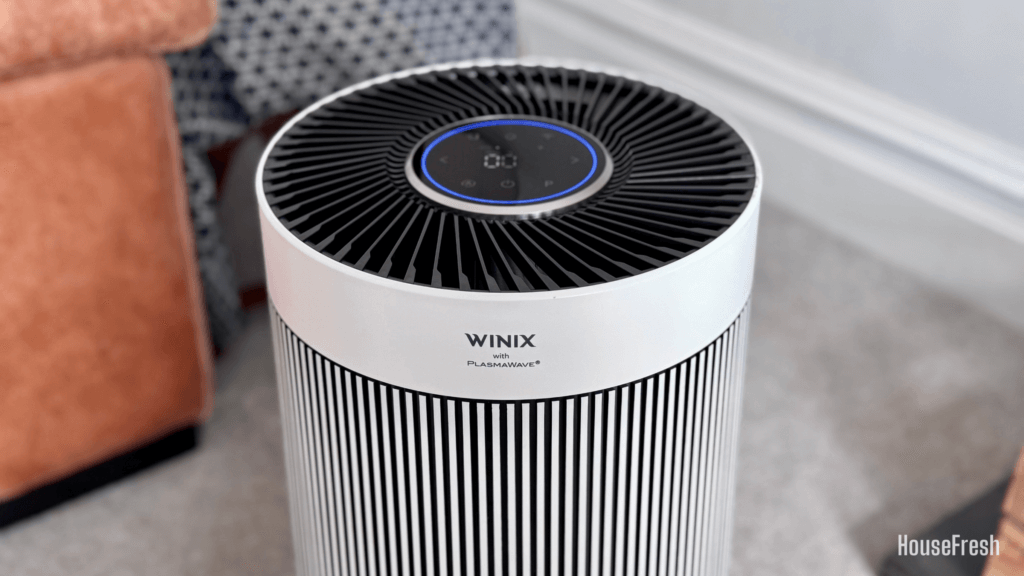
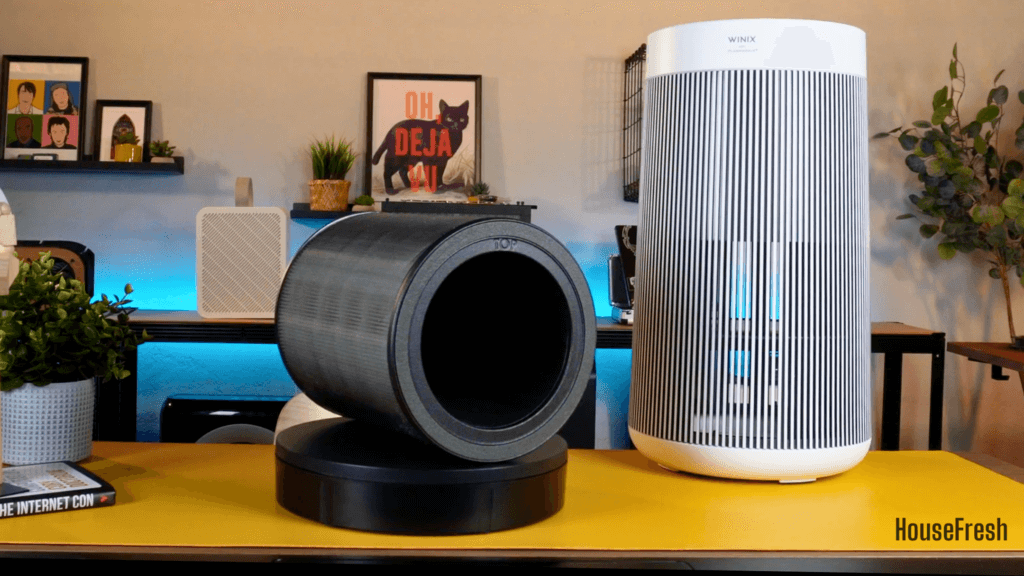
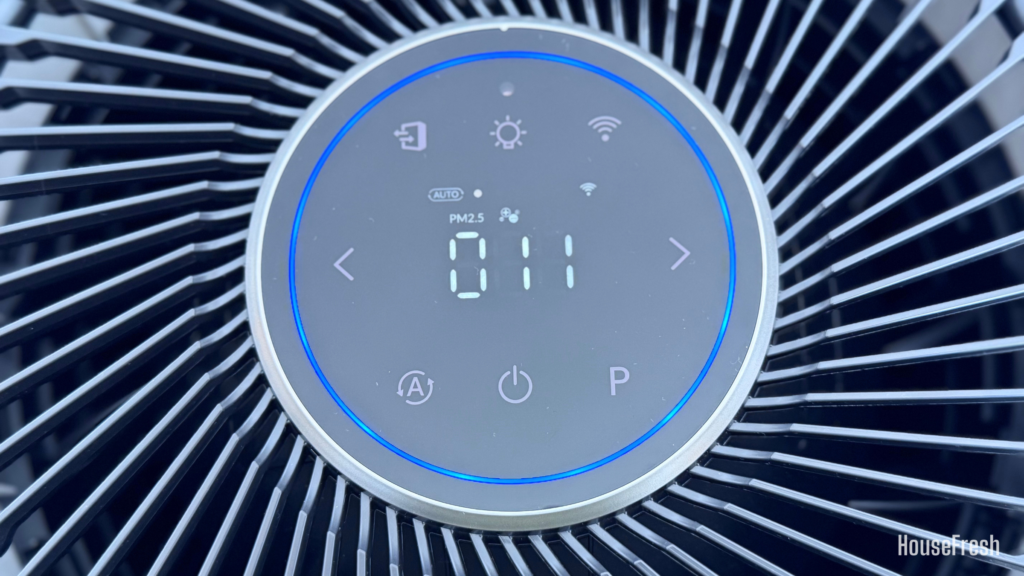
If what you want is an air purifier with above-average air cleaning performance, then you should go with the AirFanta 3Pro as the T810 is an average performer. However, if you are looking for a fashionable air purifier that won’t look out of place in even the most stylish of spaces, then the Winix T810 is the best-looking air purifier you can buy without breaking the bank.
| HouseFresh rating: | ◼️◼️◼️◼️◼️◼️◼️◻️◻️◻️ 7/10 |
| Time to reach PM1 zero (running at top speed in our 728 cubic feet test room): | – 26 minutes (top speed) – 46 minutes (sub-45 dB speed) |
| Air filtration technology: | True HEPA particle filter with carbon and pre-filter mesh |
| Ionization technology: | PlasmaWave bipolar ionization that can be disabled |
| Recommended room size (5 air changes per hour): | 343 sq. ft. |
| Clean air delivery rate (CADR): | – HouseFresh PM1: 229 cfm – AHAM PM2.5: 267 cfm (dust) |
| Dimensions (in inches / in cm): | 11.3 x 11.3 x 20.4 in (28.7 x 28.7 x 51.8 cm) |
| Weight (in pounds / in kg): | 10.4 lbs (4.7 kg) |
| Filter life: | 12 months |
| Noise level in decibels (measured from 3 ft. away with a sound level meter): | – Sleep mode: 35.1 dBA – Speed 1: 37.4 dBA – Speed 2: 44.8 dBA – Speed 3: 50.3 dBA – Speed 4: 62.5 dBA (top speed) |
| Electricity consumption in watts (recorded with an electricity usage monitor): | – Standby: 0.52 watts – Sleep more: 2.2 watts – Speed 1: 4.40 watts (4.72 w/PlasmaWave) – Speed 2: 8.23 watts (8.47 w/PlasmaWave) – Speed 3: 12.30 watts (13.42 w/PlasmaWave) – Speed 4: 41.92 watts (42.59 w/PlasmaWave) |
| Estimated running cost (electricity consumption + official filter replacement): | – Energy consumption: $47.31 per year – Filter replacement: $79.99 per year |
| Manufacturer’s warranty: | 2 years |
| Country of manufacture: | Thailand |
8. Best for offices and classrooms: Smart Air Blast Mini
A robust, powerful, quiet and no-nonsense air purifier with a massive fan and filter that can effectively clean the air in large rooms.
With 435 CFM (740 m³/h), the Blast Mini boasts one of the highest CADR ratings across all the air purifiers we have tested to date. But what’s incredible about it is that its powerful air cleaning power doesn’t come with unbearable noise attached to it. At its highest fan speed, this air purifier hits only 56.3 dBA, which is quieter than the much much smaller Levoit Vital 200S at the top of this list.
CONS
PROS
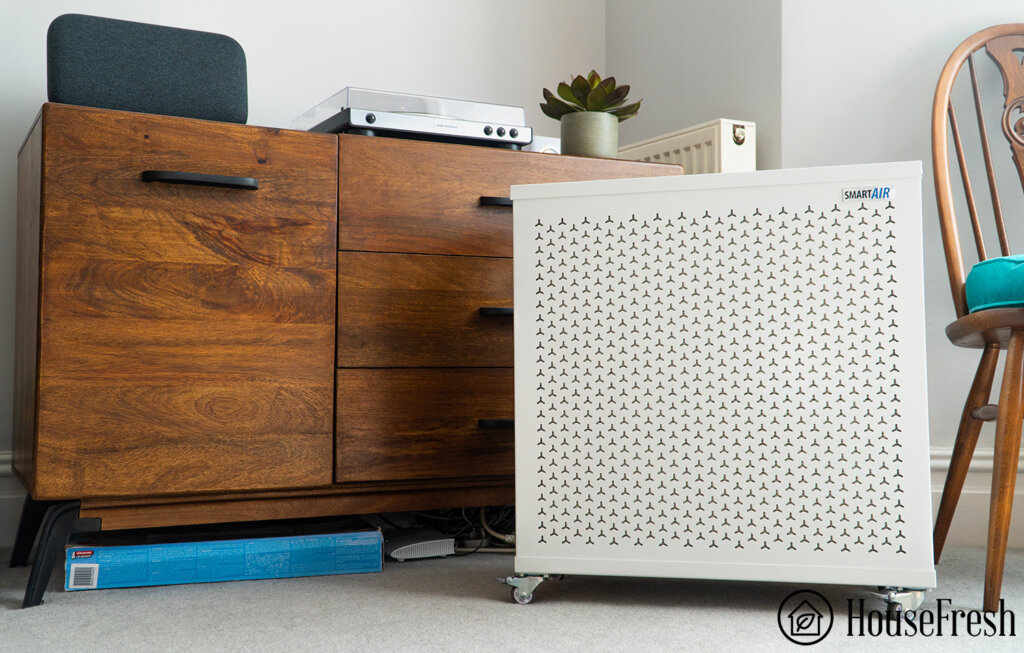
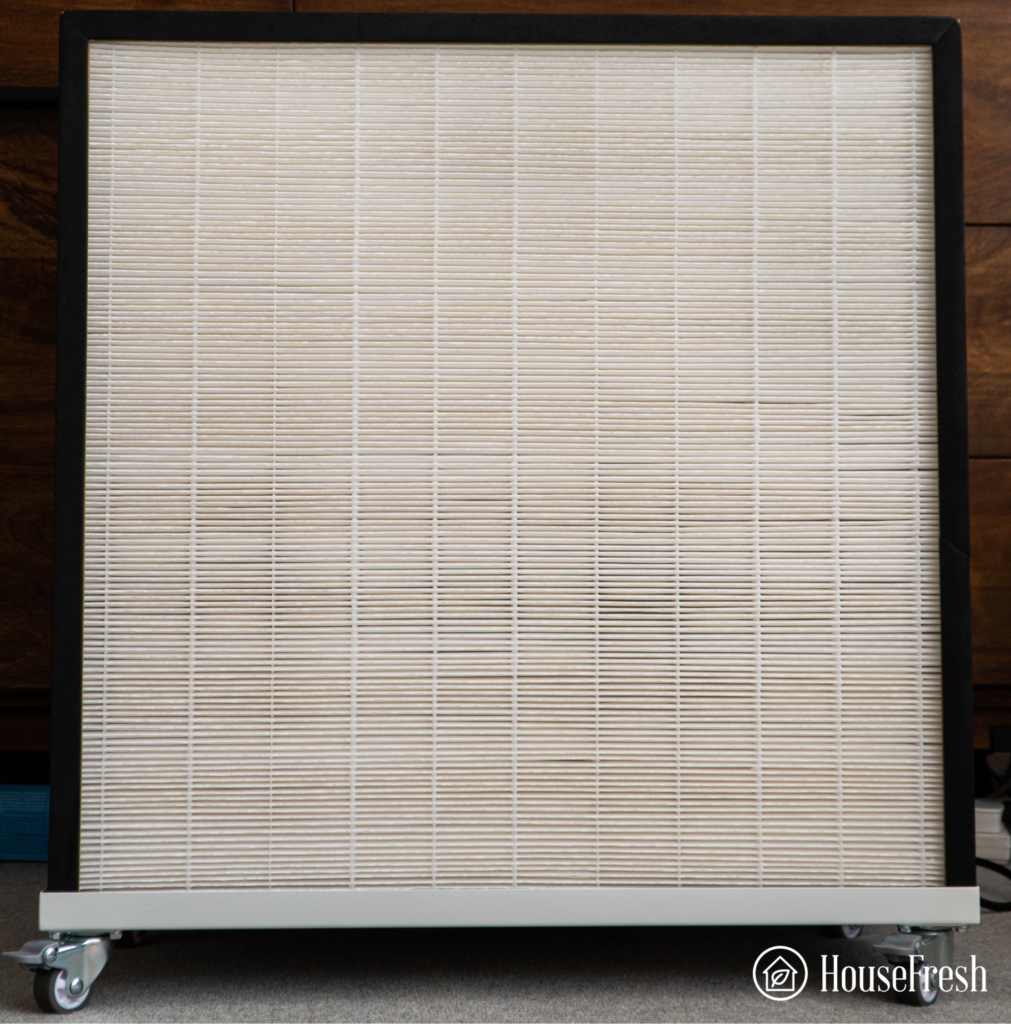

The combination of a low level of noise generated and a high CADR makes the Blast Mini an excellent choice for situations requiring clean air without high levels of noise that could have a negative effect on concentration, like a classroom or office.
It’s not cheap at $599, but if you have the funds and want the best air cleaning for large spaces with the least amount of noise, the Smart Air Blast Mini is the device you should buy.
| HouseFresh rating: | ★★★★★ |
| Time to clean our 728 cubic feet test room (with the device running at top speed): | 15 minutes |
| Air purifier technology: | H13 HEPA filter (and optional activated carbon filter) |
| Recommended room size (4.8 air changes per hour): | 703 sq. ft. |
| Clean air delivery rate (estimated CADR): | 435 CFM |
| Dimensions (in inches / in cm): | 22.6L x 13W x 24.8H inches (57.5L × 33W × 63H cm) |
| Weight (in pounds / in kg): | 59 lbs (26.8 kg) |
| Filter life: | 13 months |
| Noise level in decibels (measured from 3 ft. away with a sound level meter): | Speed 1: 44.9 dB Speed 2: 51.2 dB Speed 3: 56.3 dB |
| Electricity consumption in watts (recorded with an electricity usage monitor): | Standby mode: 0 watts Speed 1: 51.9 watts Speed 2: 87.4 watts Speed 3: 122.7 watts |
| Estimated running cost (electricity consumption + official filter replacement): | $285.29 per year |
| Cost per CADR cfm (based on dust CFM as reported by AHAM): | $1.38 |
| Manufacturer’s warranty: | 1 year |
| Country of manufacture: | China |
9. Best you can build yourself: Corsi–Rosenthal Box
A DIY approach to air purifiers that can democratize indoor air cleaning.

The Corsi–Rosenthal Box (or CR Box for short) was popularized during the early days of the COVID-19 pandemic to help people clean their air with items they could find at home: a standard box fan, four MERV-13 HVAC filters, duct tape and cardboard. While a high-quality commercial device offers long-term and quality-of-life benefits, a DIY air cleaner can be the best option for those who need a swift air purifying solution due to wildfire smoke or an unexpected airborne pandemic.
CONS
PROS



An air purifier is just a fan and a filter and the CR box is a perfect example of this. Even with MERV 13 filters, which are lower-graded compared to HEPA, it removed PM1 (particles measuring 1 micron) from our 728 cubic feet test room in 30 minutes. But don’t just take our word for it; the EPA tested it and found it to be 99% effective at removing airborne viruses.
| HouseFresh rating: | ★★★★☆ |
| Time to clean our 728 cubic feet test room (with the device running at top speed): | 30 minutes (with a cardboard shroud) |
| Air purifier technology: | MERV 13 |
| Recommended room size (5 air changes per hour): | 411 sq. ft. |
| Clean air delivery rate (CADR): | Estimated: 274 CFM |
| Dimensions (in inches / in cm): | 20L x 20W x 20H inches (50L x 50W x 50H cm) |
| Weight (in pounds / in kg): | 10 lbs (4.5 kg) |
| Filter life: | 6-12 months |
| Noise level in decibels (measured from 3 ft. away with a sound level meter): | Speed 1: 49 dB Speed 2: 55.1 dB Speed 3: 60.7 dB |
| Electricity consumption in watts (recorded with an electricity usage monitor): | Standby mode: 0 kWh Speed 1: 40.5 kWh Speed 2: 44.5 kWh Speed 3: 46.7 kWh |
| Estimated running cost (electricity consumption + official filter replacement): | $110.88 per year |
| Cost per CADR cfm (based on dust CFM as reported by AHAM): | $0.29 |
| Manufacturer’s warranty: | n/a |
| Country of manufacture: | China |
Special mentions
Five good-performing air purifiers that didn’t make the cut, but that could be a good choice for you.
While we only wanted to feature the best of the best units we’ve tested, it’s also worth mentioning some other air purifiers with outstanding performance.

Smart Air SA600
It has two HEPA H13 filters and two activated carbon filters, and performance is on par with the Vital 200S but it is more expensive. It doesn’t have smart features and I really liked that the lights on the control panel go off automatically. If you’re looking for a powerful air purifier without any smart functions that can be mounted on the wall, then the SA600 could be the one for you.

Xiaomi Pro 4
It has the same shape and roughly the same size as the Levoit Core 600S but it comes with an ionizer function. It also has a non-HEPA particle filter and a gas filter that (according to Xiaomi) has 650 grams of activated carbon pellets. It has smart functions and app connectivity through the Xiaomi app, which could be a benefit if you already have Xiaomi smart devices.

CleanAirKits Triple Exhalaron
It comes with three PC fans and three cylindrical H10 HEPA filters, and has a CADR of 120 cfm at a whisper quiet 40.5 dBA, offering better performance than the popular Levoit Core 300. Sadly, at $359, it is an expensive small air purifier that won’t be suitable for most budgets. However, if you are looking for a small air purifier you can use as a table centerpiece or inside a vehicle, then the Exhalaron might be the right choice for you.

Coway Airmega AP-1512HH Mighty
It comes with a True HEPA filter and a layer of carbon impregnated fabric, and has a dust CADR of 247 cfm – solid. However, after testing nearly 100 air purifiers, I personally feel it is now a little dated. In 2025, there are better options for performance per $ spent (AirFanta 3Pro), energy efficiency (Vital 200S), sound generated (Luggable XL-7) and odor removal (Winix 5500-2).

Levoit Core 400S
It has smartphone connectivity and comes with the largest amount of carbon of any Levoit device when choosing the Smoke Remover filter. Its performance is on par with other air purifiers on this list but I believe there are newer models (such as the Levoit Vital 200S or the Winix T810) that offer a better bang for your buck compared to what you get with the Core 400S.
Other models that we tested but don’t recommend
These devices are a bad investment, based on how overpriced and underperforming they all are.
Unlike most consumer products, the work of an air purifier is hidden from the naked eye. Unless you use a high-grade laser sensor, you will have no idea if all the tinniest particles have been removed from your air.
We have been disappointed to see many air purifiers fail to live up to expectations set by marketing materials. We like to make consumers aware of these overpriced and underpowered devices, backed by the air cleaning performance test data we gather with every review we conduct.
- Okaysou AirMax 10L Pro – This device became a best-seller on Amazon thanks to a successful influencer campaign on TikTok. In our testing, it failed to match the hype or price point. We found that Okaysou used marketing tricks to inflate its performance. I would avoid any Okaysou device. Update 26 June 2024: Okaysou is now bankrupt, and you can no longer buy it and their 5-year warranty is now worthless.
- Molekule Air Mini+ – Molekule has been touting its new PECO technology but has had to remove many of its previous marketing messages due to misleading advertising claims and class action lawsuits due to the lack of performance. In our test, it was very poor at removing PM1 particles and emitted 86 dB at its highest fan speed — louder than a leafblower! If this device is recommended in 2025, know that this is due to the high commission for the publisher recommending it, as they start at $349 and go up to $999 with the Pro series.
- Rainbow RainMate – This is an old device that is still touted as being able to clean the air. However, it was the worst-performing device in our tests, making me think that water air-cleaning is totally useless in even the smallest of home rooms. Don’t rely on this device to clean your air; stick to a good old mechanical filtration.
- PuroAir 240 – Previously sold under the name ‘PuroAir HEPA 14 240’, the PuroAir 240 didn’t live up to the marketing spiel. After completing all our tests, we found that this air purifier has poor air cleaning performance for its price and is too underpowered to clean spaces of up to 1,100 sq. ft., which is something that is mentioned multiple times in the marketing materials and on PuroAir’s website.
What to look for when buying an air purifier
The basic things you need to consider to make sure you’re not being duped into buying a device that won’t help.
The qualities you should look for in an air purifier will differ if you want to reduce allergy triggers at home, live near a busy road, need to improve your air quality during wildfire season or deal with pet odors and dander. However, some things will always be important.
1. The size of the room and the CADR (clean air delivery rate) of the air purifier.
It’s vital to analyze these two aspects together, considering many brands overstate the cleaning performance of their units. It’s not necessarily unfunded, but there’s a catch.
According to the EPA, for an air purifier to be truly effective, it should be able to perform 4.8 air changes per hour (or ACH) in a room. Unfortunately, some brands will advertise the room size coverage to achieve just one ACH, being able to claim a somewhat opaque wider coverage.
The rule is simple: a higher CADR (stated in CFM, or cubic feet per meter) means greater cleaning power. Instead of focusing on room sizes recommended by the manufacturer, look at the CADR rating.
The best way to go about it is to figure out how powerful an air purifier needs to be for your space’s specific dimensions. You can use our calculator to do just that:
2. The filtration system
Pure mechanical purifiers stand their ground on efficiency and safety when it comes to air filtration. The most comprehensive systems feature three stages:
- A pre-filter to trap larger particles that would otherwise clog the main filter faster. The best units feature a removable pre-filter, making it easier to vacuum, rinse and keep in top shape. But you may find the pre-filter attached to the main one in budget air purifiers. It’s better than not having one, but it’s also harder to clean.
- An activated carbon filter to adsorb gasses and smells. If you need an air purifier to deal with mold spores, for example, an activated carbon filter won’t be absolutely necessary, as spores are not gases but particles.
But if you are after a device to help you reduce unwanted smells or deal with chemicals and VOCs, then an activated carbon filter will be able to do what particle filters (like HEPA or MERV 13) cannot.
Activated carbon is a sorbent media that traps gas molecules on its porous surface. If you need powerful VOCs or odor filtration, look out for pelleted or granular activated carbon, which has a wider surface to collect pollutants. An impregnated carbon fabric filter is not as remotely efficient as pelleted charcoal, but it can help reduce mild everyday smells.
- Lastly, the main particle filter will remove microscopic particles from the airstream. HEPA-grade filters can remove at least 99.97% of particulate matter as small as 0.3 microns.
Yet, a denser filter just for the sake of it—like with PuroAir’s HEPA 14—is not necessarily equivalent to a better performance. On the contrary, it’s important to balance fan power and filter thickness. If a filter is too dense and the air purifier is not potent enough to draw a good amount of air and pass it through, the cleaning power is reduced. It takes longer to remove airborne pollutants with restricted airflow.
Many mechanical air purifiers also feature a built-in ionizer that can boost the units’ CADR and efficiency. Although ionizing technology is continuously evolving, at HouseFresh, we prefer those units where, like in the Winix A230 or the 5500-2 included in the list, the ionizing function can be disabled at the user’s convenience.
3. Noise output
The fan that powers your air purifier can generate a lot of noise, and you are unlikely to want to use your unit regularly if this noise becomes too much. That is why it’s worth factoring in how noisy the unit will be, especially when running at its top fan speed. This is particularly important if you want an air purifier for the bedroom or your home office.
Two things to consider:
- Smaller units won’t make much of a difference to the air when running at the slowest fan speed, and they tend to be noisier than larger ones at top speed.
- Some air purifiers suited for big spaces can be whisper-quiet when running at their lowest fan speeds, so it is worth going bigger to get a unit that will run quieter.
4. Long-term costs
In addition to the upfront cost of buying an air purifier, you should also consider associated maintenance costs such as energy usage and filter replacement.
Running your air purifier 24/7 2ill substantially improve your air, but that also means an appliance adding to your electricity bill all day, year-round. The good news is that many energy-efficient units out there won’t significantly affect your monthly expenses. However, make sure to check this to avoid unpleasant surprises, as some units are on the power-hungry side.
A few things to consider in terms of filters:
- Filter replacement costs vary among brands and models — and so does the required replacement frequency.
- The longer a unit has been on the market, the more probable good-quality generic filters will be available.
- More and more brands are offering convenient filter subscriptions that are cost-effective and include perks for happier customers.
5. Extra features
An extensive control panel with smart functions, app support, onboard air quality sensors or remote controls are handy perks that can make life easier. A no-lights mode for the bedroom, for example, is definitely something worth considering.
However, if asked, I would recommend not to sacrifice CADR or performance over fancier tech-y bonuses. After all, the purpose of an air purifier is to clean the air.
How we test air purifiers
Saying we tested 104 air purifiers in the last four years sounds great, doesn’t it? But what does testing mean for HouseFresh?
It’s definitely not just getting the units out of their boxes to take some cool editorial pictures for our articles. On the contrary, it is a thorough process that involves reliable testing devices to cover the many aspects of air purifier evaluation.
Air cleaning performance is key, for sure. But we go further. When you decide to invest in an air purifier that will be constantly running at home, things like long-term costs and noise output are also important in a real-world context.
Our testing process includes the following steps:
Step 1. We conduct a particle removal test
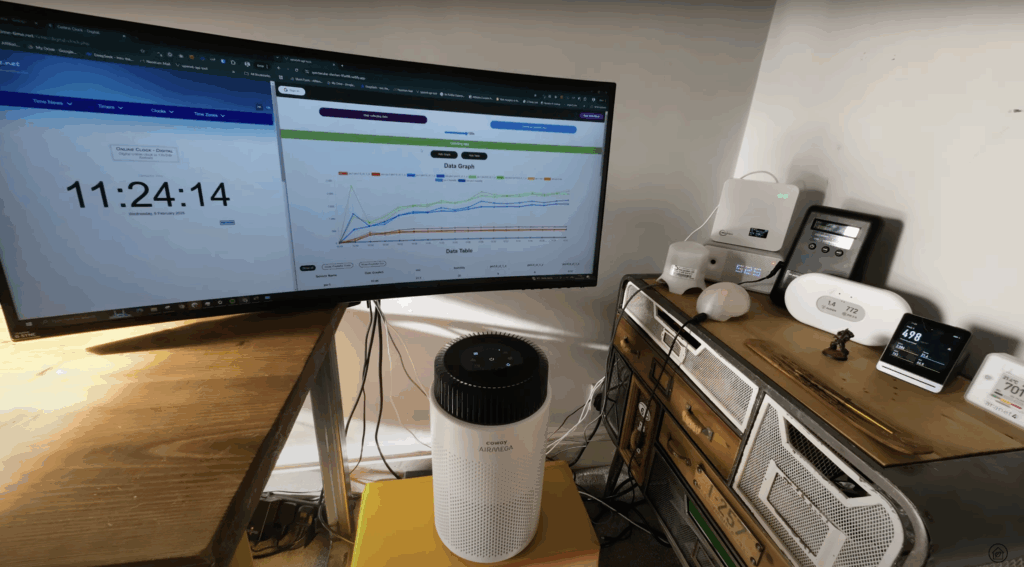
First, we burn some incense to pollute the air. Using our PurpleAir indoor sensor (which we’ve chosen after thorough research), we measure how fast each unit can remove PM10, PM1 and PM2.5 at top fan speed. The PurpleAir sensor provides regular updates on particulate matter levels, allowing us to create graphs showing the evolution of air quality in the room.
Step 2. We assess the power of the fan

We also measure the unit’s fan power with the Testo 410i anemometer. It’s interesting to see the variation in airflow coming out of the unit at every fan speed. Especially considering the AHAM Verified program measures CADR at the highest speed setting.
Step 3. We measure sound levels generated
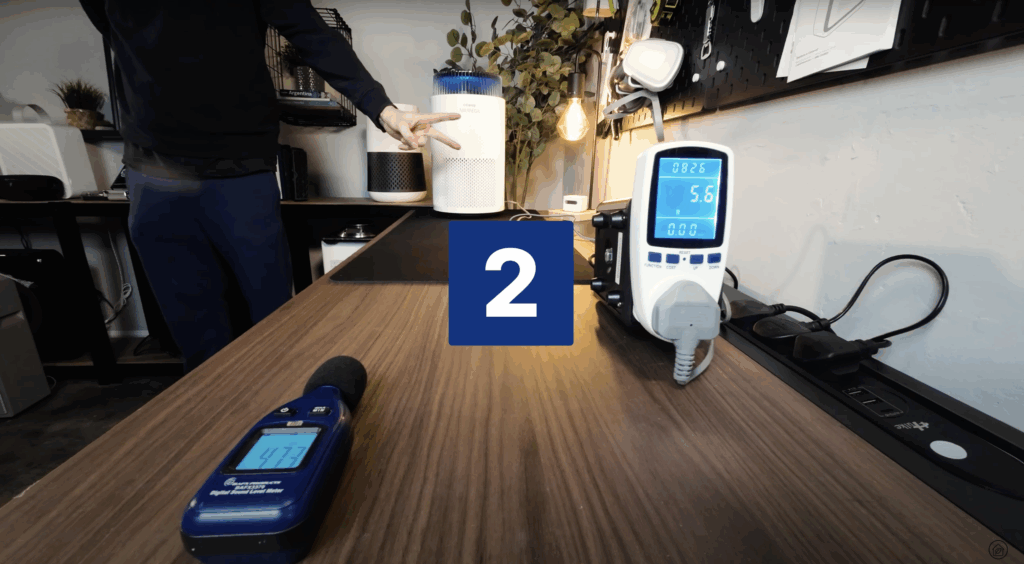
For noise levels, we use a commercial sound meter from 3 ft. away to measure how much noise in decibels (dB) is generated by the air purifier at each fan speed. Like other measurements, the data is displayed in our reviews, but we also share the results on HouseFresh YouTube channel.
Step 4. We measure electricity consumption
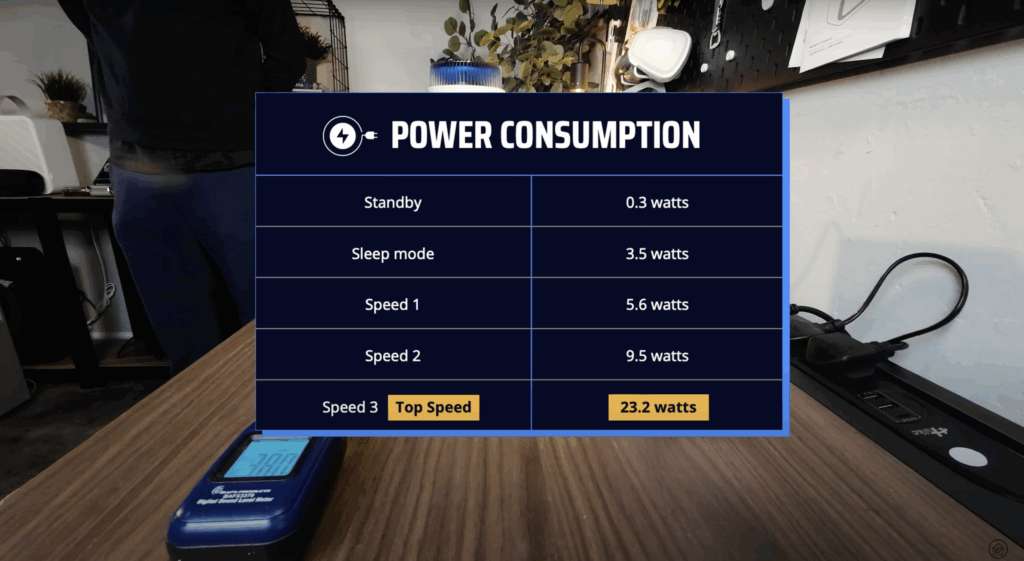
We use a power meter to record how much electricity (in watts) the air purifier consumes when running at each of its fan speeds, including sleep mode and stand-by mode.
Step 5. We estimate yearly maintenance costs
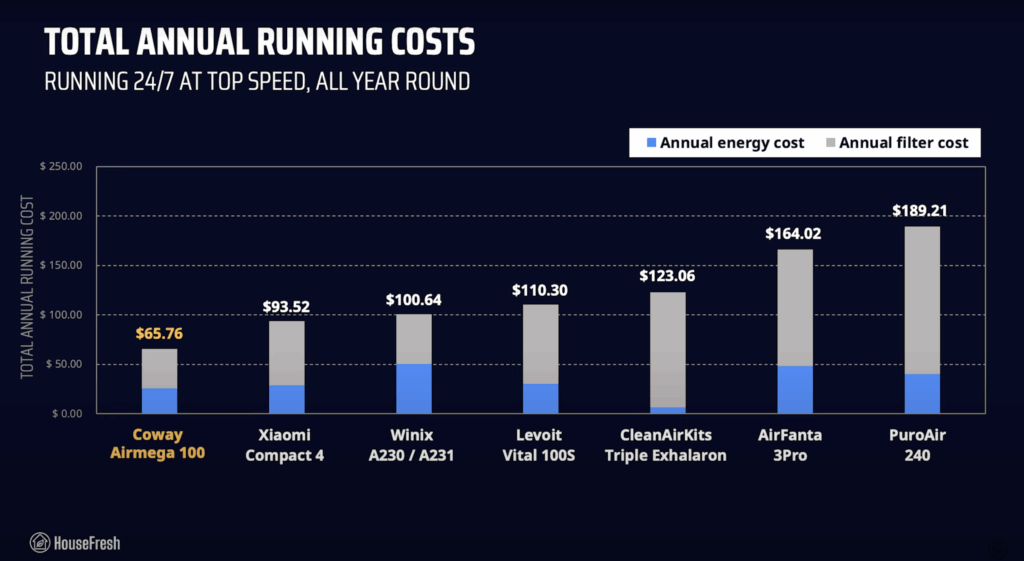
We also calculate the long-term costs you can expect to spend each year to run the air purifier. First, we use the appliance energy calculator from the U.S. Department of Energy to calculate how much money running the air purifier will add to your yearly energy bill. Next, we conduct desk research to determine the costs of genuine and generic replacement filters, using filter lifespan information stated by the manufacturer.
Step 6. Real-life experience
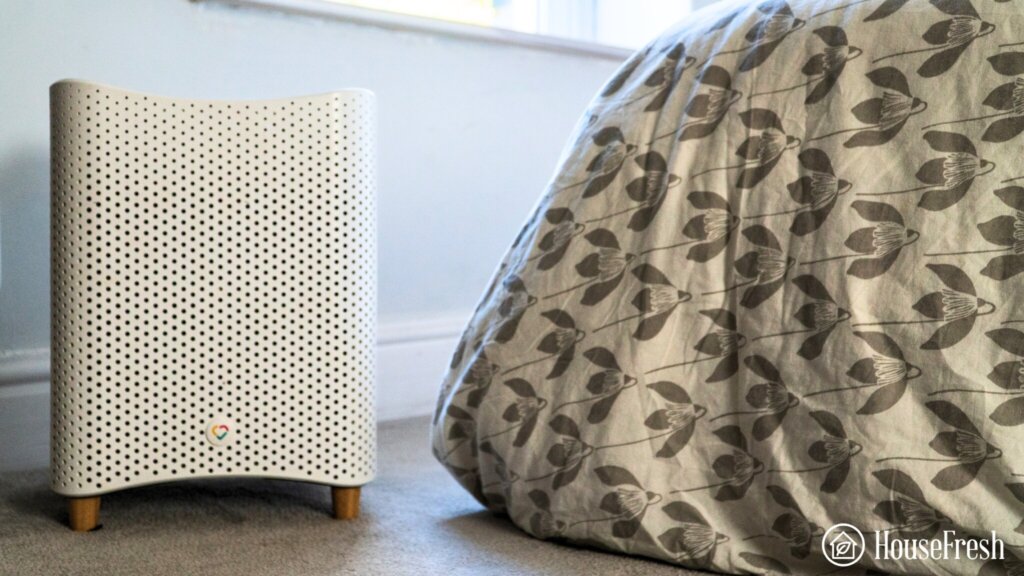
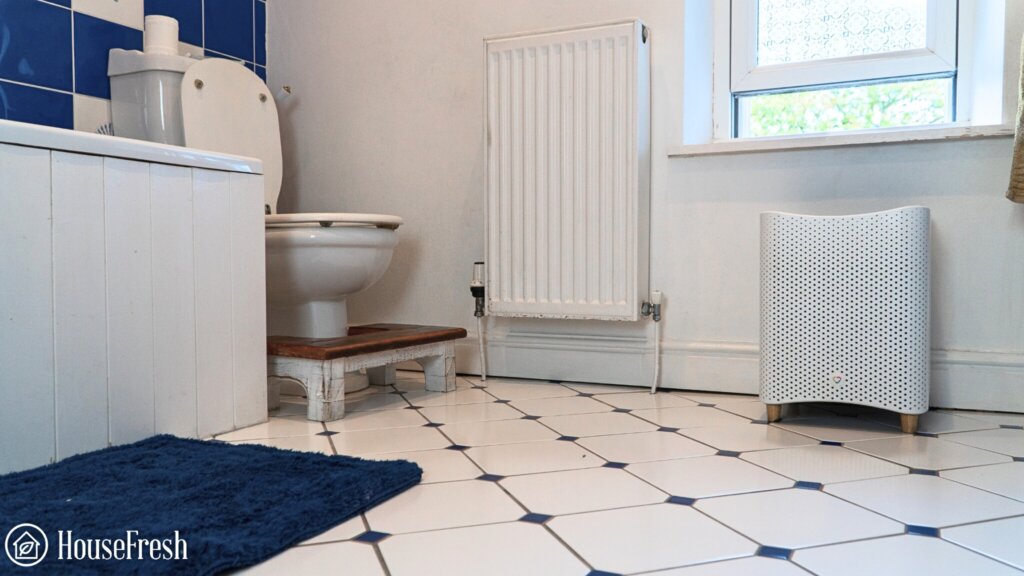

All four steps comprise the core performance evaluation we run on every unit. We know the data is solid. However, there’s something about everyday use that cannot be measured in a lab-test situation. That is why our “final step” is using the air purifier regularly at home in an ordinary context. You can learn a lot by just living with a device.
Common questions people have about air purifiers
After conducting a quick Google search, a few brands monopolize the #1 air purifier ranking, including Coway, Blueair and Levoit. It makes sense, as these are all popular brands that have also been on the market for quite a long time. Most publications, however, don’t share much of their testing process, not to mention results or data, which are rather on the unexisting side.
Right now, based on our own published test results, the Leovit Vital 200S has proven to be a versatile and reliable unit that outshines many great units with a budget-friendly price point, plenty of smart features, but most importantly, a high CADR of 245 CFM capable of delivering five air changes per hour in rooms up to 375 sq. ft.
It depends. More often than not, expensive air purifiers get boosted because the associated commissions are higher than those for budget-friendly air purifiers. There are plenty of overpriced units out there with shockingly low cleaning performance that are best to avoid, such as the PuroAir 240 or the Molekule Mini.
However, some expensive air purifiers are definitely worth considering. Take the IQAir HealthPro Plus, for example. It’s a pricey unit, no doubt. But you get certified quality for a life-long unit that will tackle any pollutant in your home.
Smart features also build up in a unit’s price tag, so if you are into auto modes, air quality readings or remote app control, you might consider chipping in an extra buck.
Usually, one powerful air purifier is more convenient than two or more smaller units. Although a bigger, high-performing unit will have a larger footprint and take up more space, the long-term costs (filters, energy bills) and noise output would be doubled or tripled with more than one air purifier running constantly.
That being said, if you have a very large space (think 800+ sq. ft.), then you might be better off placing multiple air purifiers around the room. In this thorough guide to ventilation and air cleaners you will find an example of someone who chose multiple units to clean the air in her large loft.
Finding the right spot to place an air purifier is key. Height is only one variable, but ensuring the unit is far enough from the wall or furnishing to draw in enough air is as important. And so it is that the air purifier has the right CADR to effectively achieve enough ACH in the room.
Now, in terms of height, ideal placement will depend on the use you’ll give the air purifier. In bedrooms, for example, it is best to place the unit 2-3 ft off the ground to take advantage of the clean airflow as you lie sleeping. But if the unit will be in the kitchen, where you spend most of the time standing, it would be best to put it a tad higher, about 4-5 feet off the ground. The idea is to keep the air outlet close to the source of pollutants and to your breathing zone.
Short answer: yes, air purifiers definitely remove dust.
The woven fiber maze of HEPA filters captures larger, coarse particles (such as pollen, dead skin flakes, dust mites, mold spores, pet fur or dander) and tiny ones as small as 0.3 and sometimes 0.1 microns (fine dust, soot, smoke, viruses and bacteria).
As this particulate matter (usually called PM10 and PM2.5, referring to the particle sizes) is trapped by the filter, it’s permanently removed, unable to reenter your indoor air.
There are a few things to consider:
- Placement: Finding the right spot for your unit is of utmost importance. You’ll ensure optimal airflow by avoiding obstructions on both the air inlet and outlet.
- Maintenance: Replace the filters when needed and keep the unit clean, removing any particle or dust deposition on the fan, controls, inlet and outlet. A not-so-demanding routine will help keep your air purifier in top shape for longer.
- CADR: Make sure to choose a unit with the right CADR for the room in which you’ll be placing it. If the CADR is too small, it will make little difference to your air. Try to stick to 200 cfm as a minimum if you can afford it.
According to several studies, particulate matter (PM) and VOCs (such as ozone) are potent oxidants that induce oxidative stress in our organism.
Oxidative stress can trigger immune system responses, with adverse health effects including inflammation of the airways, organs and tissues. These can then lead to lung diseases, such as asthma and OCPD. Inflammation can also decrease blood flow (or increase blood pressure), potentially predisposing cardiovascular diseases.
By removing PM and VOCs from our indoor air, air purifiers can, in fact, reduce harmful responses of the immune system, among many other health benefits.
Wrapping up
Air pollution is real. Over one-third of Americans still live in areas with unhealthy air and suffer from the consequences to their health. Improving our indoor air shouldn’t be something to take lightly.
Considering how a high-performing air purifier can improve people’s daily lives, it’s somewhat infuriating to find the internet flooded with unfounded reviews of air purifiers that lack the research and data to back them up.
Our goal at HouseFresh is to help consumers find the right air purifier to fit their needs and budgets in real-life situations. We don’t take free units from manufacturers and are not afraid to raise our voices when a hyped unit turns out to be a disappointment. Most importantly, we are driven by a transparent, hands-on approach and constantly improving methods of real-life testing.
We want our readers to find actual, helpful solutions. We may not always address all of your doubts in our articles. That’s why my mailbox is always open: danny@housefresh.com
Since 2020, we’ve been conducting our tests in the same 728-square-foot room to gather comparable data. We buy every device with our own money because we don’t want any strings attached. We are data-driven, and all our findings are openly published on the site.
Performing our tests in the same location under the same conditions allows us to compare air purifiers like-for-like in order to draw consistent conclusions. With all this data in hand, we are able to compare performance across different air purifiers from different manufacturers to quickly identify the best units for unique scenarios or situations, no matter how specific or average these may be.
We are confident that our tests reveal what manufacturers won’t tell you. That is why we don’t blindly repeat manufacturers’ specifications and marketing claims without further research or hands-on testing. We know that in many cases, their data has a degree of bias, with with many brands overstating the capabilities of their devices with clever marketing and outright lies.
June 26th, 2025
- Trimmed the text for the devices under ‘Special mentions’.
- Removed the big table with all my top picks at the top, as it wasn’t working well on mobile.
May 11th, 2025
- Replace the Winix 5500-2 with the Winix 5510 after we learned that the 5500-2 has been discontinued.
- Removed auto-play videos from the ‘How we test’ section and replaced them with photos of one of our latest tests.
April 3rd, 2025
- Included a new category (best performing stylish air purifier) after receiving emails from people looking for a more ‘fashionable’ recommendation.
- Added a quick list with all the shortlisted air purifiers at the top of the article with jump links for people who want to navigate faster through the page.
January 2nd, 2025
- After learning that that the mighty TaoTronics AP-003 has been discontinued, we added a new budget option (the AirFanta 3Pro).
- Included a new category (best performing quiet air purifier) after many people requested a recommendation under 40 dB of noise.
- Updated the results of our particle removal test for all units, based on data collected with our new PurpleAir Zen sensor, replacing the data from our older PurpleAir Indoor sensor.
November 10th, 2024
- Embedded our video with 10 things you need to know before buying an air purifier into the buying guide section of the article.
- Updated the FAQ section to clarify when it makes sense to buy multiple small air purifiers over a large unit.
October 4th, 2024
- Added two alternatives to the TaoTronics AP-003 as it has become nearly impossible to find in stock. We tested two devices based on the same ODM KJ35-G-S1 model: the Lago air purifier for the U.S. and the Midea Smart Air SmartAir Pure Control for those in Europe and Asia.
July 12th, 2024
- Embedded our new CADR calculator into the buying guide of the article.
May 24th, 2024
- Removed internal links and made layout changes after receiving advice on potential reasons why Google had demoted our website, taking away 90% of our search traffic.
April 26th, 2024
- Embedded our video shortlisting the best air purifiers of 2024 based on our test data collected between 2020 and 2023.





